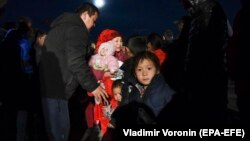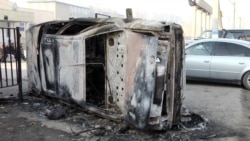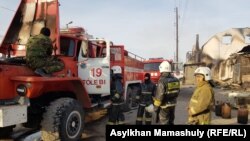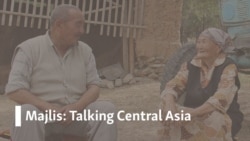
Interethnic violence has broken out again in southeastern Kazakhstan, this time involving ethnic Kazakhs and members of Kazakhstan's Dungan community.
There are various accounts of what sparked the violence between the two groups on February 7 near the town of Kordai in Zhambyl Province.
But as often happens in these situations, the violence was fueled by rumors spread over mobile phones and social media, leaving 10 people dead, dozens injured, and thousands of Dungans fleeing across the border into neighboring Kyrgyzstan.
The Dungans are a predominantly Muslim group who came into Central Asia from China, where they are called Hui.
Dungans are generally considered ethnically Han Chinese but, according to some sources, can trace their origins back more than 1,000 years. According to some sources, Dungans have an Arab-Islamic connection that dates back to the seventh century in the ethnogenesis of the Dungan/Hui. That would make them one of the oldest Muslim peoples in Inner Asia.
The Dungans also have a unique language that is neither Chinese nor Turkic.
Large numbers of Dungans began arriving in Central Asia during the latter half of the 19th century, when Chinese troops put down revolts of non-Chinese peoples in what is now called Xinjiang.
More than 100,000 Dungans now live in Central Asia, concentrated mainly in Kyrgyzstan and Kazakhstan.
The Dungans adapted to life under the rule of the Russian tsars as well as Soviet domination. They've also adapted to post-Soviet life in independent Kyrgyzstan and Kazakhstan, though they have maintained their culture. Dungans rarely marry outside their own community.
Towns and villages in Kazakhstan like Masanchi -- which bore the brunt of the February 7 violence -- continue to be populated predominantly by Dungans. That made Dungans in Masanchi easy targets for an angry crowd of Kazakhs involved in the area's latest round of violence.
Ethnic Tensions
Southeastern Kazakhstan has also seen clashes involving ethnic Kazakhs and other minorities in recent years.
In March and April 2007, there was fighting between ethnic Kazakhs and Chechens in Malovodnoye, a village in Almaty Province about 100 kilometers east of the Kordai district. That incident started at a billiard hall but quickly spread to involve hundreds of people from both communities.
The Chechens involved were the descendants of people who were forcibly resettled in the area on the orders of Soviet leader Josef Stalin during World War II.
In February 2015, clashes also broke out between members of the country's Kazakh majority and ethnic Tajiks in the predominantly ethnic Tajik village of Bostandyk in Turkestan Province.
Kazakhstan's Turkestan Province is situated immediately to the west of Zhambyl Province. Ethnic Tajiks were moved there by Soviet authorities during the 1950s to augment the region's labor force.
That violence reportedly started after an argument between a young ethnic Tajik man and a purported friend of his, a young ethnic Kazakh man, escalated into a stabbing in which the Kazakh was killed.
After the victim's funeral, a large group of Kazakhs went on a rampage in Bostandyk, setting fire to buildings and cars.
Authorities Overwhelmed
This latest violence in the Kordai district appears to have stemmed from a February 5 "road rage" incident in which an elderly ethnic Kazakh man was purportedly beaten up by an ethnic Dungan driver.
There are conflicting reports about exactly what happened in the road-rage incident and how anger in different communities was fueled by claims being made on social media.
But 48 hours later, a group of ethnic Kazakhs entered the town of Masanchi, triggering street fights in which hunting rifles, iron bars, sticks, and stones were used.
Video of violence in Masanchi posted on social networks attracted more people from neighboring areas to Masanchi and predominantly Dungan villages in the region.
Police were overwhelmed. The violence was only brought under control when special security forces from the Interior Ministry arrived.
The government in Nur-Sultan has blamed local officials for allowing the situation to get out of control. But the nearby violence in 2007 and in 2015 shows that ethnic tensions exist across southeastern Kazakhstan.
Whether people chose to settle in southeastern Kazakhstan or were forced to resettle there, the area is clearly unique and demands special consideration by officials in Nur Sultan.
Yet it seems clear that Kazakh authorities have not paid sufficient attention to the region -- leaving critics to predict that the recent violence in the Kordai district is bound to happen again somewhere in southeastern Kazakhstan.











